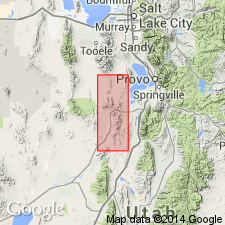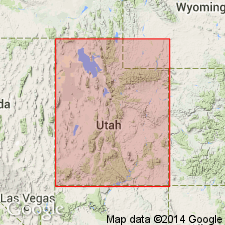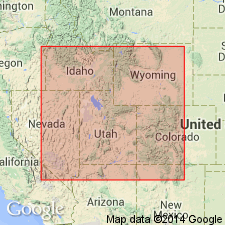
- Usage in publication:
-
- Tetro member*
- Modifications:
-
- Overview
- AAPG geologic province:
-
- Wasatch uplift
- Great Basin province
Summary:
Is the middle member of the Deseret limestone. Can be easily distinguished in the mining district, Juab Co, UT in the Great Basin province and Utah Co, UT on the Wasatch uplift. Measured section in SE1/4 SE1/4 sec 19 and SW1/4 SW1/4 sec 20, T10S, R2W where the member is 475 ft thick and it overlies the phosphatic shale member and underlies Uncle Joe member. Consists of blue-gray streaked and mottled lighter gray, medium-grained limestone with some nodular and bedded chert. Bryozoan and coral fossils identified. Of Late Mississippian age.
Source: GNU records (USGS DDS-6; Denver GNULEX).

- Usage in publication:
-
- Tetro Member*
- Modifications:
-
- Revised
- AAPG geologic province:
-
- Wasatch uplift
Summary:
Overlies Delle Phosphatic Member (new name that replaces phosphatic member), basal member of Deseret Limestone in Ophir Canyon, Oquirrh Mountains, UT on Wasatch uplift. Term Tetro equivalent applied to member of Little Flat Formation above the Delle in Little Flat Canyon, Chesterfield Range, Bannock Co, ID in Snake River basin. Correlation with other lithostratigraphic units in Great Basin province, and Wasatch uplift, UT, and Snake River basin, ID, shown on correlation chart. Of Osagean and Meramecian, or Early and Late Mississippian age.
Source: GNU records (USGS DDS-6; Denver GNULEX).

- Usage in publication:
-
- Tetro Member*
- Modifications:
-
- Overview
- AAPG geologic province:
-
- Wasatch uplift
- Great Basin province
Summary:
Assigned as a middle member of the Deseret Limestone. Lies above the Delle Phosphatic Member of the Deseret and beneath the Uncle Joe Member of the Deseret in the San Francisco, East Tintic, and Wasatch Mountains; and in the Star Point, Pavant, and Oquirrh Ranges, UT (Wasatch uplift and Great Basin province). Correlation charts. Divided in Oquirrh Range into a lower carbonate, middle clastic, and upper carbonate unit; the lower carbonate unit is in the Mamet foram zone 10 of Osagean age. In the Pavant Range, the upper part of the Tetro is in the Mamet foram zone 13 of Meramecian age.
Source: GNU records (USGS DDS-6; Denver GNULEX).
For more information, please contact Nancy Stamm, Geologic Names Committee Secretary.
Asterisk (*) indicates published by U.S. Geological Survey authors.
"No current usage" (†) implies that a name has been abandoned or has fallen into disuse. Former usage and, if known, replacement name given in parentheses ( ).
Slash (/) indicates name conflicts with nomenclatural guidelines (CSN, 1933; ACSN, 1961, 1970; NACSN, 1983, 2005, 2021). May be explained within brackets ([ ]).

